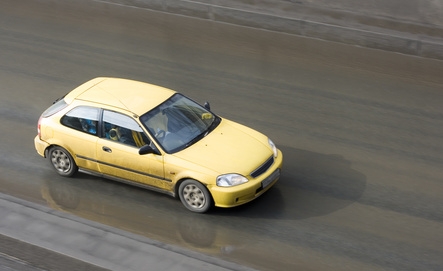
Chances are if you have a deep connection to your car, you try to protect it as best as you can. It's the reason why you park it as far away as possible from any other cars at the store so it doesn't get dinged by another shopper. But no matter how much you try to protect your car, it still may end up with some paint scrapes. A scrape may be the result of a runaway shopping cart, or someone could have thought it was funny to key your car. Regardless of the cause of the scrape, the task at hand calls for repairing the damage that has been done.
Scrub the car panel with soap to remove any dirt that is on the surface of the car that can cause problems with the paint adhering. Use a wax remover to remove any wax that can interfere during the painting process. Allow it to dry.
Sand the scratch slowly with 2,000- to 3,000-grit, wet/dry sandpaper and a sanding block, using small movements following the length of the scrape. Sand about 1 or 2 inches of the area around the scrape. Using fine sandpaper can help you avoid creating scratches as you sand. The goal is to sand the scrape until you reach the level of the scratch without having to go any further than necessary. A good tip is to rub a shoe polish into the scratch so you know how far you have to sand. Continue to sand until there isn't any shoe polish left in the scratch. Use a shoe polish that contrasts the color of the car. Dust away sanding debris with a fiber towel.
Fill in deep scratches with a body compound and a plastic putty knife. Do not use metal putty knifes, as they will create more scratches. Allow the body compound to harden as recommended by the manufacturer.
Sand the repaired area with 2,000-grit sandpaper until it's smooth. Use the fiber towel to remove sanding dust.
Mask off surrounding areas with masking tape so you don't accidentally paint them. Leave a few inches around the car scrape.
Spray the damaged area with an automotive primer, using an even motion. Keep the spray moving so you don't end up with a blotchy area. Leave it to dry overnight.
Check if you can find the paint color code in the glove compartment or the side of the door frame. Ask your local auto parts store if they can help you find the exact color match for your car. Bring along your VIN number so they can run a computer match to find the matching touch-up paint. The VIN number on vehicles is usually located on places such as the driver door jamb, dashboard on the driver's side, or trunk under the spare tire.
Paint the repaired area with the automotive touch-up paint. Use the applicator brush to apply a light coat of paint, using even, parallel strokes. Apply as many coats of paint as you need. Allow at least five to 10 minutes between the coats of paint. Allow the paint to dry as recommended on the label instructions.
Sand the repaired area with 1,000-grit sandpaper to remove any uneven areas or surface irregularities. Be as gentle as possible. Work your way up to 2,000-grit sandpaper and 3,000-grit sandpaper until the area is smooth.